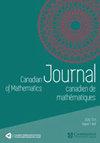通过不变量枚举三象限行走:一些对角对称模型
IF 0.7
3区 数学
Q3 MATHEMATICS
Canadian Journal of Mathematics-Journal Canadien De Mathematiques
Pub Date : 2021-12-10
DOI:10.4153/S0008414X22000487
引用次数: 7
摘要
在过去的$20$年里,局限于一个凸锥归一化为第一象限的平面点阵行走的枚举受到了广泛的关注,刺激了几种原始方法的发展,并产生了丰富的结果集合。这些结果大多涉及相关生成函数的性质:哪些模型是代数的,d -有限的,d -代数的?通过模型,我们的意思是允许步骤的有限集合。最近,对于非凸锥,特别是三象限锥$\mathcal {C} = \{ (i,j) : i \geq 0 \text { or } j \geq 0 \}$,提出了类似的问题。结果证明它们比象限的同类更难。在本文中,我们研究了$\mathcal {C}$中八个模型的集合,这些模型可以看作是超越象限问题的第一级难度。该集合由$\{-1, 0,1\}^2\setminus \{(-1,1), (1,-1)\}$中的对角线对称模型组成。其中三个已知不是d代数的。我们表明,剩下的五个可以用Tutte的不变量概念以统一的方式解决,这已经被证明对一些象限模型很有用。发现三个模型是代数的,一个是(仅)d有限的,最后一个是(仅)d代数的。我们也用同样的方法求解对角线模型$\{ \nearrow , \nwarrow , \swarrow , \searrow \}$,它是d有限的。这三种代数模型是Kreweras三部曲$\mathcal S=\{\nearrow , \leftarrow , \downarrow \}$、$\mathcal S^*=\{\rightarrow , \uparrow , \swarrow \}$和$\mathcal S\cup \mathcal S^*$的代数模型。我们的解决方案对所有六种模型都采用类似的形式。粗略地说,步长为$\mathcal S$的三象限行走生成函数的平方是步长为$\mathscr S:= \{(j-i,j): (i,j) \in \mathcal S\}$的象限生成函数的显式有理函数。我们推导了各种精确或渐近的推论,包括在$\mathcal C$中对至少是d有限的五个模型(反转)的正调和函数的显式代数描述。本文章由计算机程序翻译,如有差异,请以英文原文为准。
Enumeration of three-quadrant walks via invariants: some diagonally symmetric models
Abstract In the past
$20$
years, the enumeration of plane lattice walks confined to a convex cone—normalized into the first quadrant—has received a lot of attention, stimulated the development of several original approaches, and led to a rich collection of results. Most of these results deal with the nature of the associated generating function: for which models is it algebraic, D-finite, D-algebraic? By model, what we mean is a finite collection of allowed steps. More recently, similar questions have been raised for nonconvex cones, typically the three-quadrant cone
$\mathcal {C} = \{ (i,j) : i \geq 0 \text { or } j \geq 0 \}$
. They turn out to be more difficult than their quadrant counterparts. In this paper, we investigate a collection of eight models in
$\mathcal {C}$
, which can be seen as the first level of difficulty beyond quadrant problems. This collection consists of diagonally symmetric models in
$\{-1, 0,1\}^2\setminus \{(-1,1), (1,-1)\}$
. Three of them are known not to be D-algebraic. We show that the remaining five can be solved in a uniform fashion using Tutte’s notion of invariants, which has already proved useful for some quadrant models. Three models are found to be algebraic, one is (only) D-finite, and the last one is (only) D-algebraic. We also solve in the same fashion the diagonal model
$\{ \nearrow , \nwarrow , \swarrow , \searrow \}$
, which is D-finite. The three algebraic models are those of the Kreweras trilogy,
$\mathcal S=\{\nearrow , \leftarrow , \downarrow \}$
,
$\mathcal S^*=\{\rightarrow , \uparrow , \swarrow \}$
, and
$\mathcal S\cup \mathcal S^*$
. Our solutions take similar forms for all six models. Roughly speaking, the square of the generating function of three-quadrant walks with steps in
$\mathcal S$
is an explicit rational function in the quadrant generating function with steps in
$\mathscr S:= \{(j-i,j): (i,j) \in \mathcal S\}$
. We derive various exact or asymptotic corollaries, including an explicit algebraic description of a positive harmonic function in
$\mathcal C$
for the (reverses of the) five models that are at least D-finite.
求助全文
通过发布文献求助,成功后即可免费获取论文全文。
去求助
来源期刊
CiteScore
1.80
自引率
0.00%
发文量
58
审稿时长
4.5 months
期刊介绍:
The Canadian Journal of Mathematics (CJM) publishes original, high-quality research papers in all branches of mathematics. The Journal is a flagship publication of the Canadian Mathematical Society and has been published continuously since 1949. New research papers are published continuously online and collated into print issues six times each year.
To be submitted to the Journal, papers should be at least 18 pages long and may be written in English or in French. Shorter papers should be submitted to the Canadian Mathematical Bulletin.
Le Journal canadien de mathématiques (JCM) publie des articles de recherche innovants de grande qualité dans toutes les branches des mathématiques. Publication phare de la Société mathématique du Canada, il est publié en continu depuis 1949. En ligne, la revue propose constamment de nouveaux articles de recherche, puis les réunit dans des numéros imprimés six fois par année.
Les textes présentés au JCM doivent compter au moins 18 pages et être rédigés en anglais ou en français. C’est le Bulletin canadien de mathématiques qui reçoit les articles plus courts.

 求助内容:
求助内容: 应助结果提醒方式:
应助结果提醒方式:


